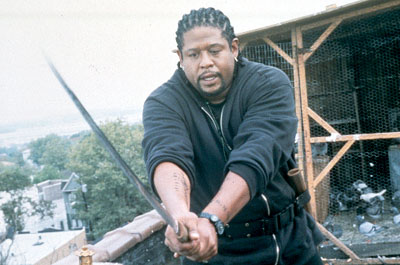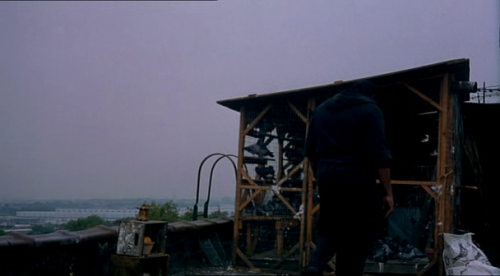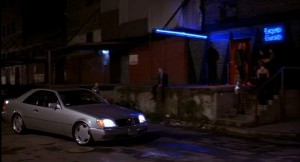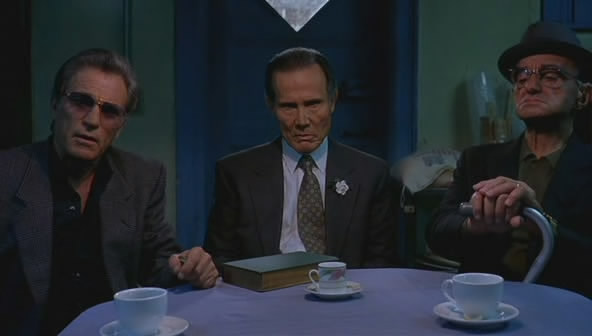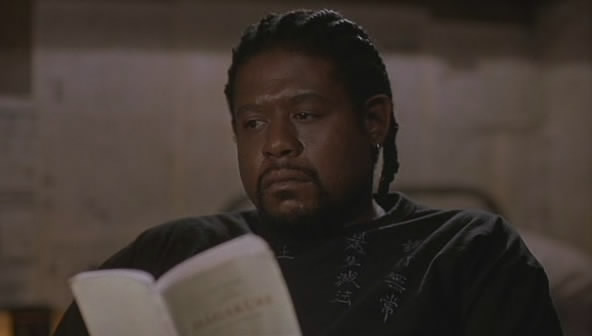From the Chicago Reader (March 17, 2000). I’m delighted that Criterion invited me to retool this review for a new edition of this film in 2020. In some ways, I like Ghost Dog more now than I did 23 years ago. — J.R.
Ghost Dog: The Way of the Samurai
Rating *** A must see
Directed and written by Jim Jarmusch
With Forest Whitaker, John Tormey, Cliff Gorman, Frank Minucci, Richard Portnow, Tricia Vessey, Henry Silva, Isaach de Bankolé, and Camille Winbush.
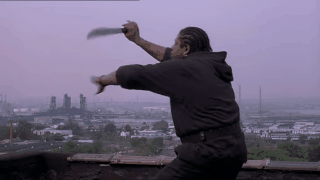
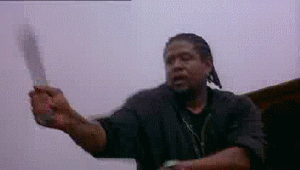
Jim Jarmusch’s seventh narrative feature, Ghost Dog: The Way of the Samurai, which I’ve seen three times, may be a failure, if only because most of its characters are never developed far enough beyond their mythic profiles to live independently of them. But if it is, it’s such an exciting, prescient, moving, and noble failure that I wouldn’t care to swap it for even three or four modest successes.
Compared with a masterpiece like its controversial predecessor, the 1995 Dead Man, Ghost Dog seems designed to get Jarmusch out of the art-house ghetto, at least in this country, and into something closer to the mainstream. It’s full of familiar elements reconfigured in unfamiliar ways: Ghost Dog (Forest Whitaker), whose life was once saved by Louie, a New Jersey hoodlum, becomes Louie’s samurai hit man, communicating with him exclusively with homing pigeons. When something goes wrong during a hit, Louie’s gang decides to wipe out Ghost Dog, who retaliates in order to defend himself.
Like Dead Man, Ghost Dog is a far more ambitious film than any of Jarmusch’s earlier works. Both films still bear traces of his origins as a New York minimalist, but Jarmusch has introduced historical references — a sense of antiquity and tradition treated with genuine gravity and an expanded sense of time to match his well-developed sense of geographical space — that have opened up his imagination and extended his thematic and affective range well beyond that of his first five features.
Some of this sense of history comes through literary references. There were brief references in some of the earlier films, such as those to Chaucer and his Canterbury Tales in Mystery Train, but the references in Dead Man and Ghost Dog are crucial. The key texts in Ghost Dog are Yamamoto Tsunetomo’s Hagakure: The Book of the Samurai (an 18th-century warrior text), Ryunosuke Akutagawa’s Rashomon and Other Stories (an early-20th-century collection), Mary Shelley’s 19th-century Frankenstein, and an undated French book about bears. These books are as important as the quotations from William Blake’s poetry in Dead Man, because they offer various kinds of life lessons and because, in one way or another, they’re shared by two or more characters and thus become touchstones. Moreover, with the exception of the Akutagawa collection, which circulates the most, all of them can be regarded as books about the movie’s title hero. Indeed, Hagakure serves as Ghost Dog’s Bible and is quoted in the film in extended intertitles no less than 13 times; the first 12 passages are read aloud by Ghost Dog, who’s offscreen, and the final passage is read aloud by Pearline, a little girl he meets in a park.
Some viewers have been irritated by all these quotations, and there’s no question that each of them stops the story dead in its tracks — paradoxically, at the same time it offers interpretive commentary on what’s going on. The quotes remind me of a rather obscure fantasy tale of the 40s by Lewis Padgett (the most frequent pen name of Henry Kuttner), “Compliments of the Author,” which is about a magical 50-page book that offers all-purpose instructions to the owner on each page about how to resolve various dilemmas — “Werewolves can’t climb oak trees,” “He’s bluffing,” “Try the windshield,” “Deny everything,” “Aim at his eye“; the relevant page number appears magically on the cover each time it’s needed, a total of ten times per owner. (Needless to say, the 50th page and last directive is “The End,” which echoes the last quotation from Hagakure in Ghost Dog: “The end is important in all things.“) The 13 quotations from Hagakure offered over the course of Ghost Dog suggest a similar metaphysical conceit — meeting a desire for discipline and purity, a need to reduce uncertainty by limiting all understanding to a single book outlining a single way of life.
Forming a dialectic with this volume is the Akutagawa collection, the opening story of which, “In a Grove,” consists of multiple contradictory accounts of the same incident from the viewpoints of separate characters. (This story forms the basis of Akira Kurosawa’s film Rashomon; confusingly, the second story, “Rashomon,” furnished the basis of Kurosawa’s sentimental framing device for the same film. The radical moral of “In the Grove” appears to be that all the versions of the same story are true; the reductive moral of Kurosawa’s framing story is that everyone lies.) Roughly speaking, Hagakure corresponds to Jarmusch’s background as a minimalist, and “In the Grove” — which suggests a multiple understanding of reality, something closer to cubism — introduces the more skeptical perspectives raised by historical speculation. (Jarmusch’s movie stresses that the favorite story of both Pearline and Ghost Dog is “In the Grove,” not “Rashomon.”)
In Ghost Dog the formal equivalent of this vision of multiplicity is a technique used in varying forms throughout the film: the lap dissolve, the means by which two or more separate images gradually overlap. Jarmusch, who’s never used lap dissolves this much before, uses them here in two distinct ways: to combine different subjects within the same shot (such as a slow pan across a city street at night and a fixed close-up of Ghost Dog) or to break up an action or moment into several instants (such as several different angles on a parked car that Ghost Dog’s approaching, or several successive stages in his progress as he walks down the street). Both procedures, carried out with real distinction in Robby Müller’s glowing cinematography, correspond with some of the sampling techniques used by disc jockeys, and at times they also correspond to some of the other cultural mixtures Jarmusch is playing with. (By contrast, one lovely extended take, which shows Ghost Dog stealing a red convertible at night while its owner steps inside a liquor store, rivals the simplicity and purity of Hagakure.) The overall process of mixing and matching evokes Jarmusch’s background as a musician and is reflected in RZA’s effective score. (I’m told that the forthcoming sound-track album will offer musical outtakes as well as other sound elements that aren’t in the movie, comprising in effect an alternative version of the movie, a “composer’s cut” similar to Neil Young’s brilliant Dead Man CD.)
From the start of his career Jarmusch has been a settler in the still barely discovered territory of global culture. He’s not simply or exclusively an “American independent” but an astute connoisseur of cultural essentials that escape boundaries of nationality, ethnicity, language, gender, and age, and he’s broaching a realm of experience and potential bonding that’s daily becoming more important to the quality of everyday life on the planet. If nothing else, wherever we happen to be living and whatever language we speak, most of us are affected by the propaganda and manufactured upheavals of the same multicorporate conglomerates — which arguably makes the whole world kin more than communism or democracy ever did.
Viewers still stuck in the limiting paradigm of national identity — according to which Jarmusch is American first and last, Abbas Kiarostami Iranian first and last, and Irma Vep some kind of report about the state of French cinema — probably see the fact that English circles the globe via the Internet as an ethnic or ideological marker rather than as a lingua franca that opens the highway to all sorts of persuasions. Within the elastic anonymity of Webspace — only one of several contemporary arenas where nationality seems increasingly outdated — it no longer seems far-fetched that a young black man might reinvent himself as an ancient Japanese warrior (one premise of Ghost Dog), that a small-time Italian-American mobster (John Tormey) and a black samurai might be “almost extinct” members of “different ancient tribes” who treat each other with reciprocal respect (another premise), that a black American samurai and a black Haitian ice cream vendor (Isaach de Bankolé) unfamiliar with each other’s language can be best friends and communicate without any difficulty (still another), or that a slim paperback of Japanese stories might be passed along with profit from a white mobster’s moll (Tricia Vessey) to the black samurai who rubs out her boyfriend to the little black girl on a park bench, who simply likes to read (Camille Winbush), and then might get passed all the way back to the moll again (yet another).
I should add that computers don’t figure at all in Ghost Dog, a movie whose sense of high tech is basically restricted to cars with fancy CD players, guns with silencers, and animated cartoons on TV, and whose sense of antiquity is inseparable from its feeling for the present cultural moment. The point is that all the movie’s characters are casually liberated and even defined by their capacity to drift between cultures: one of the aging white gangsters (Cliff Gorman) loves rap and chants along with it, and another (Henry Silva) responds to an enigmatic quotation about beheading from Hagakure by saying, “It’s poetry–the poetry of war.“
By the same token, an Iranian artist like Kiarostami might be making a more Western-oriented statement about the turn of the century by centering his latest feature, The Wind Will Carry Us, around the death of a 100-year-old woman. In some of his previous films he has synchronized his final scenes, all in Iranian settings, to the music of Vivaldi or Louis Armstrong, which has led some Iranian viewers to complain that he caters to the West. (His very first short, made 30 years ago, used a jazz version of a Beatles tune performed by Paul Desmond.) Similarly, Olivier Assayas’s Irma Vep may have more to say about what North America, Hong Kong, and France have in common than about what makes them culturally disparate.
For all the differences between Jarmusch and Kiarostami and Assayas in relation to global culture, all three are astute and easily misunderstood practitioners of DJ-like sampling, with all its possibilities and limitations. One can’t simply call global culture “good” or “bad” at this point in history because it mixes together too many potential pluses and minuses — broadening the reach and meaning of traditions and at the same time flattening them, often to the point where one has to redefine them. (The same problem crops up in evaluating the diverse menu offerings of California Pizza Kitchen outlets.)
The functioning of a film or book or piece of music within the global culture can’t be equated with its function as a piece of provincial, national, or folk art. Theoretically, Ghost Dog might be a retrograde hip-hop exercise, or a fair-to-middling American release, or an excellent example of Euro-American cinema, or a highly advanced contribution to global culture — depending on how one defines its audience. If it’s simply a movie addressed to white and black American teenagers — which is apparently how some American critics, none of them teenagers, choose to regard it — it might easily be accused of racial and ethnic simplifications that don’t move far beyond cartooning. But if it’s a multifunctional, multinational object in which dollops of hip-hop, Japanese and Victorian English literature, movies from all over, and diverse aspects of French-Haitian and Italian-American vernacular are mixed, then it needs to be judged somewhat differently. One has to decide whether its major concerns are characters or cultures, and how one decides depends to some degree on how one distinguishes between the two, even if the existential questions in each case turn out to be similar.
Ghost Dog had successful runs in Japan and France late last year, which might be partially explained by Jarmusch’s assurance in mixing and matching what he takes from the arty genre movies of both countries — in this case from two very stylish and mannerist 1967 features, Seijun Suzuki’s Branded to Kill and Jean-Pierre Melville’s Le samourai — without ever compromising his own, equally mannerist artistic identity. (I don’t know if Jarmusch has ever seen Irving Lerner’s minimalist 1958 noir and Zen thriller, Murder by Contract, a low-budget Hollywood effort, but it too seems relevant to what Ghost Dog is doing.) Jarmusch told me that last fall he made a point of showing Ghost Dog to the once-prolific, currently unemployed, 77-year-old B-film maestro Suzuki, who responded, “I see you’ve taken some things from me, and when I make my next film I’m going to take some things from you.” In any case, Japanese viewers don’t appear to object to Jarmusch’s appropriation of Japanese elements — his popularity in Japan now appears to be at its highest ever — so why should anyone object to his equally romantic and fanciful sampling of hip-hop, cartoons, and Italian-American gangster culture?
Jarmusch was juggling references of this sort, along with equally sharp music and literary references, long before anybody had heard of Quentin Tarantino — who has subsequently bypassed Jarmusch as the favorite standard-bearer for American independents, though he neither owns the negatives of his pictures nor has final cut on them, unlike Jarmusch. Generational and promotional styles obviously played some role in this supplanting, and it’s fascinating to ponder the degree to which Ghost Dog can be read, even obliquely, as Jarmusch’s gentlemanly response to Tarantino–a distinct possibility since it’s Jarmusch’s first movie about hit men, a Tarantino staple.
Though all of Jarmusch’s movies display ironic or ambivalent relationships to Hollywood models, Dead Man was actively hostile to the most all-American of Hollywood genres, the western, especially its insensitive treatments of Indians. The blunt and dark feelings expressed in that movie about racial violence, capitalism, religious hypocrisy, and frontier madness went so far, even when it was pitched as farce or satire, that a significant portion of the American public recoiled from it. (This phenomenon is discussed in more depth in a short book on the film I just finished writing for the British Film Institute, due out this fall.) Audiences aren’t likely to recoil from Ghost Dog, whose relation to hit-man thrillers is relatively respectful, regarding its aging, weary, and overweight gangsters (all beautifully cast) with some affection. (They’re behind in rent at the Chinese restaurant they use as a clubhouse, and as silly as they often are, all of them are permitted to die with a certain amount of dignity.) Indeed, the contrasting treatments of violence in the two pictures –g enerally ugly and graceless in Dead Man, most often sleek and graceful in Ghost Dog — might seem like a contradiction. When I asked Jarmusch about the discrepancy, he insisted that it could be traced back to the movies’ respective heroes: a greenhorn accountant (Johnny Depp) awkwardly forced into the role of killer, and a black youth willingly training and disciplining himself as a samurai in deference to a small-time Italian-American mobster in New Jersey who once saved his life. (The gag about them communicating with each other almost exclusively by homing pigeon seems to come from neither Japanese nor Italian sources; perhaps it can be traced back to Irma Vep‘s territory — the silent French serials of Louis Feuillade.)
Nevertheless, a couple of scenes in Ghost Dog provide striking continuities with Dead Man. Nobody (Gary Farmer) — one of the leads in Dead Man and my favorite character in Jarmusch’s oeuvre to date — makes a brief appearance in Ghost Dog, uttering his signature line in Dead Man (“Stupid fucking white man“). And a scene in which Ghost Dog encounters a couple of bear hunters on the road could have come straight out of the earlier film. (This scene occurs after the Haitian ice cream vendor has compared Ghost Dog to a bear and read aloud from the French book on the subject, and the mindless boast of one of the hunters cinches the connection: “There aren’t too many of these big black fuckers left around here, so when you get a good, clear shot at it, you take it.“) Considering that Jarmusch’s original working title for Dead Man was “Ghost Dog,” it shouldn’t be too surprising that, as different as the two films are, they’re still blood relations.
The last of the notes appended to the published version of F. Scott Fitzgerald’s unfinished novel The Last Tycoon, written in capital letters, is “action is character” — a slogan that might be regarded as Jarmusch’s watchword. More a poet than a prose writer, and more comfortable with the kind of action that comes from character than with the kind that comes from plot, Jarmusch tends to leapfrog over knots in his story lines rather than make any effort to untie them. He doesn’t tell us how the three cell mates manage to bust out of prison in Down By Law but simply cuts to the trio fleeing, and he’s similarly unconcerned with how various bounty hunters and marshals in Dead Man follow the tracks of William Blake from the town of Machine to the west coast.
In Ghost Dog he’s clearly as baffled as we are why Ray Vargo (Henry Silva) and other hoodlums who order Ghost Dog to kill Handsome Frank (Richard Portnow), a mug who’s shacking up with Ray’s daughter Louise, are so miffed when Louise is present at the hit — they thought she’d already left on a bus — that they insist Ghost Dog be rubbed out as well. A more conventional storyteller might point out that Louise was a material witness who could blab something to the cops about Ghost Dog’s identity that might be traced back to his boss or perhaps come up with another throwaway explanation. Clearly bored with such details, Jarmusch makes her equally indifferent to the death of Handsome Frank and to the identity of who shot him, then has her “lend” Ghost Dog the Akutagawa book, which she’s just finished reading. So the apparent necessity of the hit man being killed seems predicated on some obscure point of pedantry that’s never spelled out, underscoring the sense that most of what gangsters do is pretty absurd anyway.
The movie’s fascination with Ghost Dog never gives the character enough of a back story to make us believe in him as something more than a cultural premise — which, for that matter, is just about all that Alain Delon was in Melville’s Le samourai. Jarmusch daringly uses Whitaker for the most part as a hulking silent presence, going about his business in purposeful and dedicated mime, but whenever the movie requires the character to be something more than a mythic icon, we don’t know quite what to make of him. We get two slightly different versions of the flashback showing Ghost Dog’s first encounter with Louie, but that doesn’t suffice to make this movie a Rashomon. And though he and Louie view their final confrontation as a scene from a movie — “This is the final shootout scene“; “Yeah, it is” — this doesn’t suffice to make it believable, even in the highly circumscribed terms established by this movie. Nonetheless, the cultural feelings inspired by these two prototypes are stirred, and the tenderness between these and other icons somehow survives the awkward clutter.

